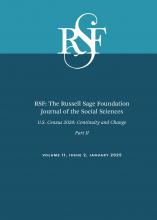Research Article
Open Access
Living Alone for Black and White Men and Women over Four Decades, 1980–2019
Hyunjoon Park, Matthew Sheen, Paula Clark
RSF: The Russell Sage Foundation Journal of the Social Sciences January 2025, 11 (2) 26-45; DOI: https://doi.org/10.7758/RSF.2025.11.2.02
Hyunjoon Park
aKorea Foundation Professor of Sociology at the University of Pennsylvania, United States
Matthew Sheen
bGraduate student in the Department of Sociology at the University of Pennsylvania, United States
Paula Clark
cHas recently earned her undergraduate degree in sociology at the University of Pennsylvania, United States

REFERENCES
- ↵
- ↵
- Bennett, Jim, and
- Mike Dixon
- ↵
- Chaloupková, Jana K
- ↵
- Chamie, Joseph
- ↵
- ↵
- Davis, Robert
- ↵
- Esteve, Albert,
- David S. Reher,
- Rocio Treviño,
- Pilar Zueras, and
- Anna Turu
- ↵
- Fischer, Claude S., and
- Michael Hout
- ↵
- Fry, Richard,
- Jeffery S. Passel, and
- D’Vera Cohn
- ↵
- Furstenberg, Frank F., Jr.
- ↵
- Gaugler, Joseph,
- Sue Duval,
- Keith A. Anderson, and
- Robert L. Lane
- ↵
- Goldstein, Dana, and
- Robert Gebeloff
- ↵
- Gurrentz, Benjamin
- ↵
- Henning-Smith, Carrie,
- Jonathan Schroeder, and
- Mariana S. Tuttle
- ↵
- Ho, Phoebe,
- Hyunjoon Park, and
- Grace Kao
- ↵
- IPUMS USA
- ↵
- Klinenberg, Eric
- ↵
- ↵
- Macvarish, Jan
- ↵
- Martin, Steven P
- ↵
- McLanahan, Sara
- ↵
- ↵
- Office of the Surgeon General
- ↵
- Pandey, Erica
- ↵
- Park, Hyunjoon, and
- Jaesung Choi
- ↵
- Pimouguet, Clément,
- Debora Rizzuto,
- Pär Schön,
- Behmaz Shakersain,
- Sara Angleman,
- Marten Lagergren
- Laura Fratiglioni, and
- Weili Xu
- ↵
- Raymo, James M.,
- Hyunjoon Park, and
- Jia Yu
- ↵
- Reher, David, and
- Miguel Requena
- ↵
- Ruggles, Steven, and
- Susan Brower
- ↵
- Ruggles, Steven,
- Sarah Flood,
- Ronald Goeken,
- Megan Schouweiler, and
- Matthew Sobek
- ↵
- Sandström, Glenn, and
- Lena Karlsson
- ↵
- Shanahan, Michael J
- ↵
- Stempowski, Deborah, and
- James Christy
- ↵
- Torr, Berna M
- ↵
- U.S. Census Bureau
- ↵
- USA Facts
In this issue
Living Alone for Black and White Men and Women over Four Decades, 1980–2019
Hyunjoon Park, Matthew Sheen, Paula Clark
RSF: The Russell Sage Foundation Journal of the Social Sciences Jan 2025, 11 (2) 26-45; DOI: 10.7758/RSF.2025.11.2.02
Jump to section
Related Articles
- No related articles found.
Cited By...
- No citing articles found.





